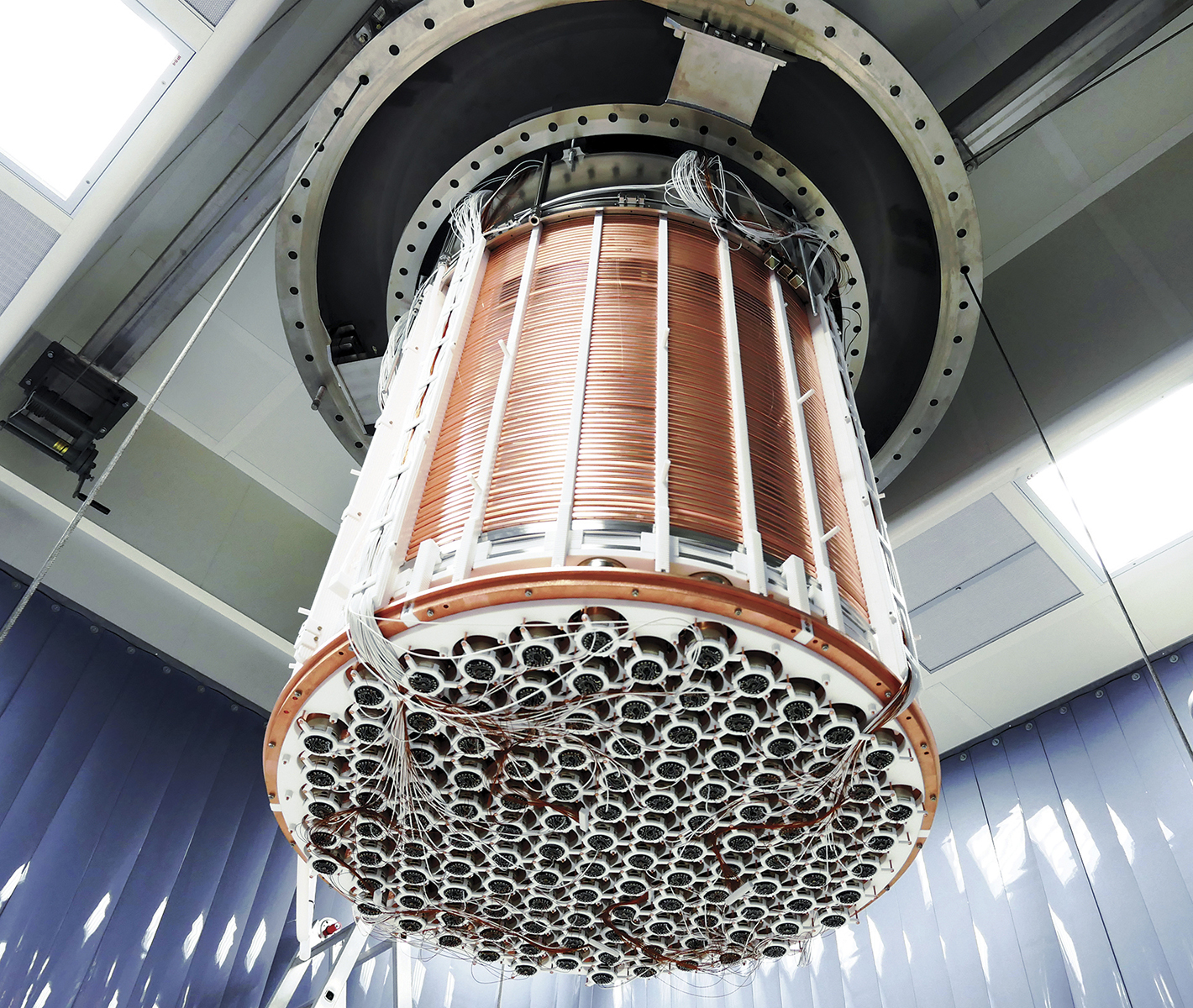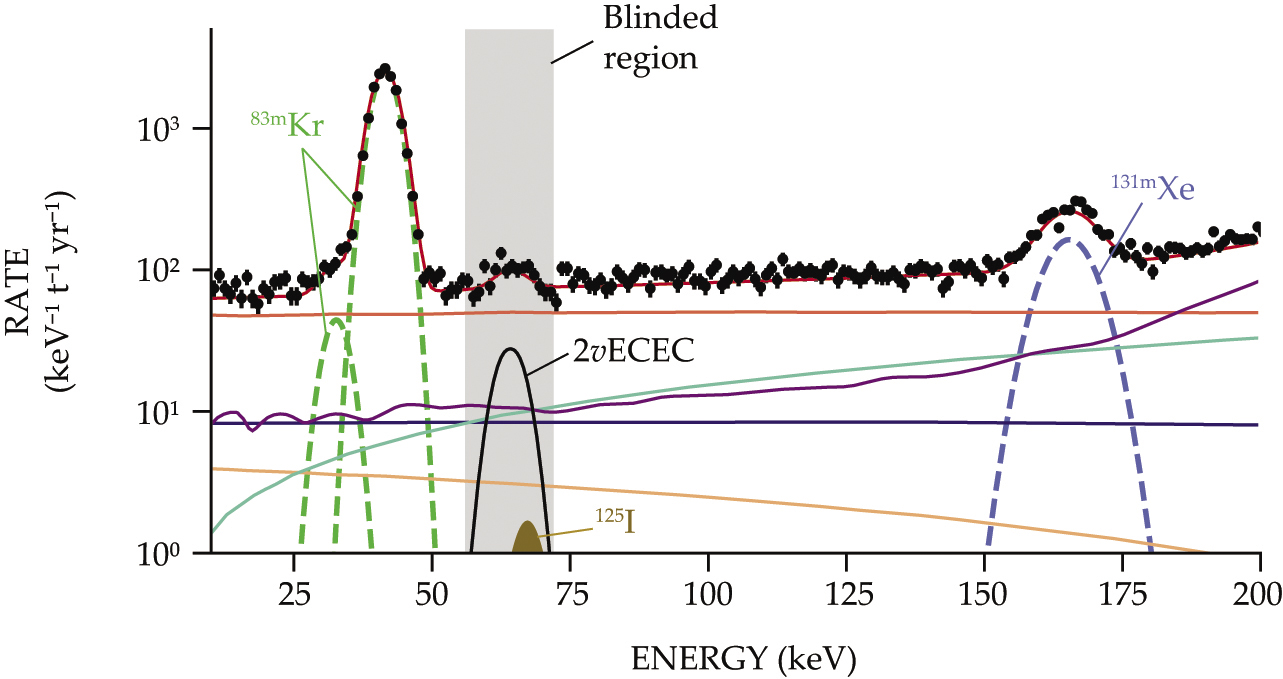Dark-matter detector observes a rare nuclear decay
DOI: 10.1063/PT.3.4242
Dark matter must exist. Gravitational phenomena such as the rotation of galaxies (see Physics Today, December 2006, page 8
What those particles are is anyone’s guess. One possibility—that dark matter is made of weakly interacting massive particles, or WIMPs—is appealing because it arises theoretically out of solutions to unrelated problems in particle physics. WIMPs, if they exist, could interact with ordinary matter not just gravitationally but also via a force on the scale of the weak interaction that neutrinos experience. So in principle, they can be detected the same way neutrinos are: Gather a large quantity of some material that’s expected to produce a distinct scattering signature, put it deep underground to shield it from cosmic rays, surround it with sensors, and wait.
Dozens of would-be WIMP detectors have been built and operated over the years in underground labs around the world. With the exception of disputed results from one group (see Physics Today, July 2016, page 28
The XENON collaboration, founded in 2002 by Elena Aprile of Columbia University, has just made that potential look a lot more like a reality. 1 With its detector—which unsurprisingly uses chilled xenon as its target material—at Gran Sasso National Laboratory in Italy, the group has observed a rare form of nuclear decay, two-neutrino double-electron capture (2νECEC), in the neutron-poor isotope 124Xe.
Figure 1.

The XENON1T detector before it was installed in 2016. The cylindrical vessel, roughly 1 m across and 1 m high, contained 3.2 tons of mostly liquid xenon at an operating temperature of −96 °C. The top and bottom faces were lined with photomultiplier tubes to detect and measure the energies of scattering events and radioactive decays. (Courtesy of the XENON collaboration.)

The result itself is not terribly startling. Nuclear theory predicts that 124Xe should undergo 2νECEC, and the measured half-life is in line with expectations. But it’s an experimental tour de force. Less than 0.1% of natural Xe is 124Xe, and its half-life, (1.8 ± 0.6) × 1022 yr, is the longest ever measured directly. As WIMP detectors continue to improve, they’ll be ready to observe even rarer events. One much-discussed possibility is the neutrinoless version of the same decay, 0νECEC. If detected, 0νECEC would establish that neutrinos are their own antiparticles and that lepton number is not conserved.
Slow decay
A cousin of two-neutrino double-beta decay (2νββ; see Physics Today, December 1987, page 19
Nuclides that undergo beta decay include tritium and carbon-14, with half-lives of 12 yr and 5700 yr, respectively. But 2νββ, which requires the weak process to happen twice simultaneously, is correspondingly more infrequent: All known half-lives are greater than 1018 yr, so it’s detectable only in nuclides for which single-beta decay is forbidden or strongly suppressed.
In general, 2νECEC is rarer still, because it requires not just two simultaneous weak events but also two electrons to be localized in the nucleus at the same time. Before XENON’s results, indications of 2νECEC had been directly observed 2 in only one nuclide, krypton-78, with a half-life of around 1022 yr. The decay mode is also known to occur in barium-130, with a half-life on the order of 1021 yr, but that was determined by analyzing geological samples for 130Ba and its daughter nuclide 130Xe, not by catching the atoms decaying in real time. 3
Many other nuclides are expected to undergo 2νECEC, but they haven’t been subjected to observation. It’s just too costly and challenging to amass enough of the isotope of interest, build a detector capable of sensing the decays, and suppress background to the point where ultrarare events become visible. But Xe-based dark-matter detectors were doing all those things anyway. As a by-product of the hunt for WIMPs, they got a 2νECEC measurement essentially for free.
Multipurpose detectors
Efforts to use Xe-based WIMP detectors to look for 2νECEC began almost a decade ago with the XMASS collaboration, whose experiment is based at the Kamioka Observatory in Japan. Because the electrons captured in 2νECEC are almost certainly the core electrons of 124Xe, the daughter atom, tellurium-124, is left in a highly excited state. As it relaxes, it produces a cascade of photons and electrons with a total detectable energy of 64 keV. The energetic particles cause the Xe to scintillate, and the emitted light is detected by photomultiplier tubes.
When the XMASS researchers looked for a peak in their energy spectrum at 64 keV, they found none. 4 They concluded that at the 90% confidence level, the decay should have a half-life longer than 2.1 × 1022 yr; otherwise, they would have observed it.
XENON also went through the motions of looking for the decay. 5 “But the experiment had no chance, since XMASS was more sensitive at that stage,” says XENON team member Alexander Fieguth of Stanford University, who worked on the project while a student at the University of Münster. At the time, XENON was using its XENON100 detector with just 165 kg of Xe, and the XMASS detector had 832 kg.
It’s typical for dark-matter groups to upgrade their detectors every few years, as they learn to overcome experimental challenges and gain more funding to buy more target material. In 2016 XENON unveiled its new XENON1T detector (shown in figure
From the start, the XENON researchers were prepared to look for 2νECEC. So they wouldn’t be biased by their perception of the results, they kept the data between 56 keV and 72 keV hidden, or blinded, until the data taking and background characterization were complete. And they took measures to combat an especially pesky source of background: When 124Xe captures a neutron, it transforms into 125Xe, then iodine-125, then an excited state of 125Te, which emits a signal at 67 keV that’s easily mistaken for the 2νECEC signal at 64 keV. They can’t prevent that sequence of reactions, but they can stop it in its tracks: The half-life of 125I is 59 days, and they can purify their detector of all iodine much faster than that.
The results, based on 177.7 days of data from 2017 and 2018, are shown in figure
Figure 2.

The energy spectrum from nearly half a year’s worth of XENON1T data. The two-neutrino double-election capture signal (2νECEC) appears as the small bump in the blinded region and is fitted by the black curve. The large green and blue peaks arise from metastable krypton and xenon nuclides used to calibrate the energy scale. All other curves represent sources of background; in particular, the small brown bump shows the expected contribution of the creation and decay of iodine-125. If the target Xe hadn’t been constantly purified to remove all iodine, that peak would be much larger. (Adapted from ref.

It may not look like much—a few hundred events, barely visible above the already low background—but it’s larger than the researchers expected. The corresponding half-life, (1.8 ± 0.6) × 1022 yr, falls in the region XMASS had excluded with 90% confidence (although the error bars extend above the XMASS lower bound). “Nature was kind to us in providing such a large signal,” says Fieguth. “It could easily have been a few times weaker, but it couldn’t have been much stronger than what we saw.”
The new generation
Detecting 2νββ is seen as a natural first step in looking for 0νββ (see Physics Today, January 2010, page 20
Because neutrinos can change flavor—an electron neutrino might turn into a muon neutrino or a tau neutrino, say—they must have three mass states that aren’t the same as the three flavor states. The three masses are all different, so at least two of them must be nonzero, but it’s not even known which one is the largest. In the so-called normal hierarchy—in which m3, the mass of the state made up mostly of the muon and tau flavor states, is largest—the half-lives of neutrinoless decays would be roughly 1029 yr. In the inverted hierarchy, in which m3 is the smallest, they’re around 1027 yr. They’re both far beyond the reach of current Xe-based detectors but could be observable by future ones.
As WIMP experiments become more sensitive, they could also double as real-time neutrino detectors in a uniquely low-energy regime. Right now, neutrinos from the Sun are just one of several sources of background—they appear as the orange curve in figure
The XENON1T detector has already been shut down, and the XENON researchers are getting ready for their next upgrade, XENONnT, with 8 tons of Xe. It will be joined in the next few years by two other new detectors: LZ (for LUX–Zeplin, a merging of the Large Underground Xenon and the Zoned Proportional Scintillation in Liquid Noble Gases experiments) in South Dakota and PandaX-4T (Particle and Astrophysical Xenon detector) in Sichuan, China. The main goal is still to look for WIMPs, but it’s now clear that that’s not all the detectors are capable of. “Maybe we’ll stumble upon something totally unexpected along the way,” says Wittweg, “as so often happens in physics.”
References
1. XENON collaboration, Nature 568, 532 (2019). https://doi.org/10.1038/s41586-019-1124-4
2. Y. M. Gavrilyuk et al., Phys. Rev. C 87, 035501 (2013); https://doi.org/10.1103/PhysRevC.87.035501
S. S. Ratkevich et al., Phys. Rev. C 96, 065502 (2017). https://doi.org/10.1103/PhysRevC.96.0655023. A. P. Meshik et al., Phys. Rev. C 64, 035205 (2001); https://doi.org/10.1103/PhysRevC.64.035205
M. Pujol et al., Geochim. Cosmochim. Acta 73, 6834 (2009). https://doi.org/10.1016/j.gca.2009.08.0024. XMASS collaboration, Prog. Theor. Exp. Phys. 2018(5), 053D03 (2018). https://doi.org/10.1093/ptep/pty053
5. E. Aprile et al. (XENON collaboration), Phys. Rev. C 95, 024605 (2017). https://doi.org/10.1103/PhysRevC.95.024605
